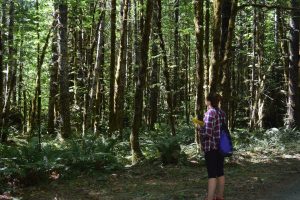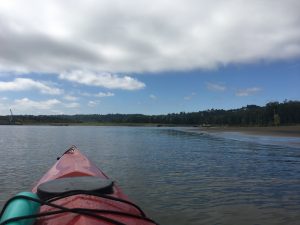As I sat on a tumbled log in the heart of the Old Growth Forest, I heard nothing but the water. Even the birds were silent; I had never experienced such peace. We left no trace as we completed our reflections in the quiet, essentially undisturbed forest. We later braced ourselves for the glacial waters of the McKenzie River where everything was natural except the floating yellow and blue rafts. Although there was some sign of human interaction with nature, the landscape was still preserved, unlike the James River. We take advantage of our urbanized river through construction and should make efforts to minimize our human impact on the once pristine environment.
What does it mean to be an urbanized river? According to Walsh and collaborators, bodies of water in cities suffer from “urban stream syndrome” which causes “flashy” hydrographs and other “symptoms” such as decreased organic matter retention, escalation of overland flow, and lowered rates of nutrient uptake (Walsh 2005). The James River shows signs of this condition and there is a chance we could treat it, but first we must acknowledge that the wilderness is in our own backyard. The problem humans have is we generally define the wilderness as a “sublime” environment separate from our homes and workplaces. Cronon explains that the wilderness is all around us and we need to accept this idea so we can more effectively protect our surroundings from the “urban stream syndrome” (Cronon 1995).
Construction has a severe impact on our local waterways, especially by means of bridges, dams, and mining. On the James River near the Huguenot Flatwater access there are the Huguenot and Willey bridges which create a primarily aesthetic disturbance to the landscape. However, the structures also escalate the flow of traffic to the area, thus increasing human impacts on the water. There are similar effects on the Willamette River due to the rise in population and construction in Portland, Oregon. In my journal on the trip, I note several instances of cranes, bridges, and tall buildings creating disruptions in the landscape along our paddle along the river (Lantz Journal).
Furthermore, dams have a more direct effect on the hydrology of streams. We paddled to Bosher Dam to take a closer look at the fish ladder that is operational during only three months of the year. Ironically, the dam serves no purpose other than to appease wealthy homeowners who enjoy the flatwater the dam creates. It was originally built to redirect water for the construction of the Kanawha Canal and is now a barrier for fish migrating during mating seasons. Before the dam, fish were able to travel as far as Lynchburg on the James River and the fish ladder is in place to make this easier for fish from March to early June (LantzBlogPost 10/16/16, EgnerBlogPost 10/15/16). Unlike the Bosher Dam, the Bonneville Dam in Cascade Locks, Oregon was built by the United States Army Corps of Engineers to produce energy for the surrounding area. There is also a fish ladder in place and at least 97 percent of the population must be able travel safely in order for the dam to remain operational and employees are constantly monitoring the fish species leading to early recognition of environmental concerns (Lantz Journal). The Bonneville Dam succeeds in reducing human impacts on the local environment and attempting to use the resources of the area without severely damaging the ecosystem.
Mining is yet another cause of disturbances in urban landscapes. The quarry in Belle Isle is a famous example in the Richmond area; companies used to mine granite from the ground, thus creating the feature seen today. The mining played a strong role in affecting the hydrology of the local ecosystem as the large hole has now filled with water, generating another drainage area. We visualized a similar concept on our paddle to Ross Island in Oregon, except workers mined gravel instead of granite. A company was granted access to the land for several years to mine, but the island has been left in shambles. The land is a nightmare for the next owner and there is an ongoing debate as to who will be responsible for cleaning it up. Humans have a history of having selfish, economic-driven goals in mind and nature is not often the first priority when it comes to construction projects.
Rivers are the heart of many cities around the world, especially Richmond and Portland. Many kayakers, white water rafters, and fishermen call the river home, the James River is celebrated by Richmonders at the Folk Festival each year, and others simply find the river peaceful. It is important for people to enjoy the river, but the preservation of the waterways is necessary to sustain the river for humans to continue using its resources. In Oregon, we saw the pure glacial water of the McKenzie River turn into the murky water of the Willamette River. Humans clearly have a significant impact on our rivers, especially in urbanized areas. Construction poses serious problems to the riparian areas in particular and expose the aquatic environment to pollution and disturbance threats.
In order to reduce mankind’s impacts, it is important to educate the population according to Professor Forsyth’s method – generating awareness of the issues and appraising constructive behaviors – which will generate a sense of community and as a result, improvements will occur. At the end of our cleanup at the Dutch Gap, there was an informative trailer teaching individuals about the impacts of litter on the ocean. It gave specific facts such as decomposition times of glass bottles, plastic bags, and Styrofoam materials as well as suggested ways of reducing these impacts. Construction companies, especially the on-site workers, should be informed of the consequences of their projects and littering to first eliminate some non-point pollution sources. Our rivers have endured human threats, but it is time for us to fix the problems we created in our local environments.
Sources:
Cronon, William. “The Trouble with Wilderness: Or, Getting Back to the Wrong Nature.” Environmental History 1.1 (1996): 7-28. Web.
Walsh, Christopher, et al. “The Urban Stream Syndrome: Current Knowledge and the Search for a Cure.” The North American Benthological Society (2005): Web.




